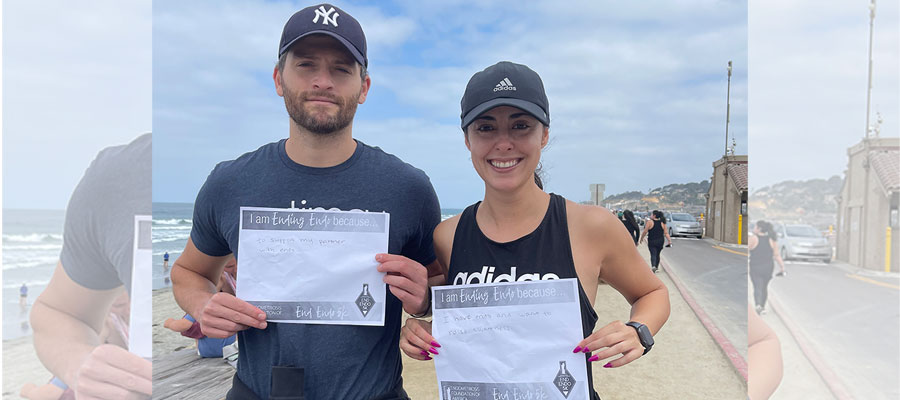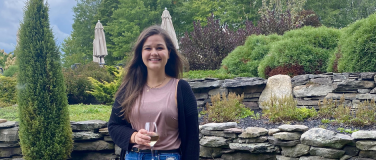
I was 11 when I felt the worst pain of my young life. I spent many days hunched over in the bathroom at home, alone and in tears, gripping the toilet paper holder and clenching my teeth.
On my first day of middle school, blood seeped through my pad and underwear and onto my pants. There I was again, this time in the school bathroom, crying. All women feel this type of pain, right? I convinced myself. This is normal. Just deal with it. Even though I always knew deep down that something didn’t feel right, these intrusive thoughts fueled by cultural and societal norms spun through my head constantly. So, I wiped my tears, cleaned myself up, and tied my sweatshirt around my waist to cover the stain on my pants for the rest of the school day.
From a young age, I was taught to be strong and independent and feared that complaining too much would be a sign of weakness. I have an incredibly kind and thoughtful mother who would do her best to soothe my pain through traditional methods. Still, because of my background and culture, I was not used to speaking with my family about my health and bodily concerns. The only thing I knew then was that I would have to overcome many obstacles to begin this journey.
Throughout the years, my pain levels and other symptoms gradually worsened. I was bleeding through super-sized tampons and pads in less than 30 minutes. As I continued to try to voice my concerns to medical professionals, I faced immense challenges. Doctors frequently dismissed my claims by saying that it was all in my head, normal for a woman, or nothing urgent. Out of sheer desperation—with mounting hospital visits, medical bills, and debilitating pain that rendered me unable to move—I turned to the emergency room. The first diagnosis I received during an ER visit was that cysts on my ovaries had ruptured. Finally, a little bit of validation. From that moment, I decided that enough was enough. I would not stop until I knew what was happening inside my body. I needed to fight for my health and life, which had taken drastic turns for the worst.
This was just the beginning of my journey to my endometriosis, polycystic ovary syndrome (PCOS), and fibromyalgia diagnoses at 29 years of age, 18 years after first experiencing symptoms.
I was living in New York when I found out that I had a cyst about the size of a small orange on my left ovary. My gynecologist assured me that it wasn’t serious and would disappear on its own. After more testing, I was told that I had PCOS. It was progress and a little more validation. But having spent so many years learning as much as I could about my body, I knew deep down that there had to be something more.
After several visits and careful consideration through hours of research, I returned to my doctor and demanded to learn more about possibly removing the cyst surgically. He begrudgingly explained what that would entail and insisted that going down that path was optional and unnecessary.
Is he kidding? I thought to myself in his office. I was furious. “This isn’t optional; this is my life!” I said to him. I needed that cyst removed and desperately needed answers. I scheduled my first surgery right then and there.
When I woke up in NYU hospital after my surgery, the first words I heard were, “Shadi, you have endometriosis.” Having just come out of anesthesia, I closed my eyes and felt like I was living a nightmare. Yet, after waking up in recovery, as I waited for the doctor, I felt something I hadn’t felt in a very long time: relief. I had finally gotten the answer I’d sought for so many years.
But the real battle was just beginning.
The doctor came into the room to explain what he had found. He said the cyst was actually an endometrioma, and he also found several lesions throughout my body. But my relief quickly dissipated when he said that he could not remove any of it because he was not a specialist. He had only drained some of the cyst. I now had to find an endometriosis specialist, and I was told that finding one in my insurance network would be another colossal challenge I’d have to face.
Not knowing much about endometriosis at the time and desperate for help, I allowed a specialist I found who was out of my insurance network to put me on Lupron. He was highly rated, and I trusted his opinion. It was a huge mistake. I went to the specialist to get a painful monthly shot every month for seven months, which put my body into an induced state of menopause. Menopause at the age of 30 was an experience I never thought I’d have. Not only did the Lupron not help my current symptoms, but it added a whole new list of other symptoms. I was physically unable to continue, despite the specialist recommending several more months of treatment. Once again, I had to fight for myself and listen to my body. I stopped seeing that specialist but didn’t know where to turn.
During this time, my partner was researching ways for me to manage my condition and came across a book called Beating Endo. The book spoke about the only holistic approach to endometriosis that I had come across, and it was one I agreed with. The book was written by an endometriosis specialist based in Los Angeles, and I made an appointment for a consultation with him. At that stage, I was debilitated for weeks at a time and on the verge of losing my career, so we decided to move back home to California during the pandemic to find adequate care. A cross-country move during a global pandemic accurately sums up the extremes I have had to endure to fight to get back any quality of life.
After my consultation, I felt relief again—I had finally found a doctor who listened, cared, and understood. He assured me he would work with me for as long as it took to help me improve my life and manage this condition. That’s when I began my six-month journey to prepare my body for a second surgery, which took an army of healthcare practitioners in pain management, gastroenterology, physical therapy, mental health, acupuncture, and other holistic health modalities.
Fast forward three years—my entire life has changed. I have had excision surgery to remove all lesions and my appendix. I’ve spent most days at doctor’s appointments and in physical therapy, commuting between San Diego and Los Angeles to receive care. I’ve completely changed my career and many other aspects of my lifestyle, including giving up alcohol, changing my diet, and exercising differently. During this time, I have also experienced severe permanent damage due to the Lupron and have been diagnosed with fibromyalgia.
For years, I felt this condition had taken everything from me. It changed who I was and stole my identity. But as I reflected and mourned the life I had lost, I realized something: I wouldn’t ever stop fighting. I am truly capable of anything, including building a beautiful life I could have never imagined. As I fight these chronic illnesses, I have learned that allowing myself to truly feel each emotion and take each moment as it comes has been critical in my journey. I have learned that pain, frustration, sadness, relief, and happiness can coexist in different moments. While things have changed drastically in my life, some things will remain the same. I will never stop fighting, learning, growing, and advocating for myself and others. And I will never surrender my happiness to an illness that has taken so much from me.
Thank you,
Shadi
Editor's note: Would you like to contribute to EndoStories? Click here to learn how to submit your work.
*Patient stories submitted to EndoFound.org are the patient's views, not necessarily those of the foundation. All testimonials are from real patients, may not reflect the typical patient’s experience, and are not intended to represent or guarantee that anyone will achieve the same or similar results.









